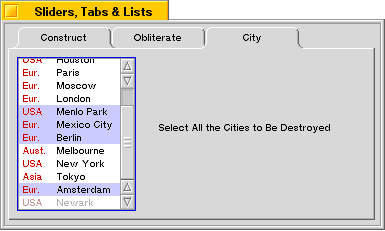A BListItem
represents a single item in a
BListView (or
BOutlineListView).
The BListItem
object provides drawing instructions
that can draw the item (through
DrawItem()),
and keeps track of the item's state. To use a
BListItem,
you must add it to a
BListView
through
BListView::AddItem()
(BOutlineListView
provides additional item-adding functions). The
BListView
object provides the drawing context for the
BListItem's
DrawItem()
function.
BListItem
is abstract; each subclass must implement
DrawItem().
BStringItem—the
only
BListItem
subclass provided by Be—implements the function to draw the item as a line of text. For
an example of a custom
BListView
subclass, see "Creating a Custom List Item".
A BListItem
object doesn't automatically get redrawn when the item
changes. If you change a list item's content or state, you must tell the item's owner (the
BListView object) to redraw the item by calling
BListView::InvalidateItem().
For example:
/* listItem belongs to listView. We change the state of the item... */listItem->SetEnabled(false); /* ...so we have to tell the list view to redraw it. */listView->LockLooper();listView->InvalidateItem(listView->IndexOf(listItem));listView->UnlockLooper();
If you're making a lot of changes, you can flush them all at the same
time through a single
BView::Invalidate() call:
listItemA->SetEnabled(false);listItemB->SetEnabled(false);listItemC->SetEnabled(false);listView->LockLooper();listView->Invalidate();listView->UnlockLooper();
Note that you don't have to lock the list view's window to change one of its items—you only have to lock the window when you talk to the list view itself.
BListView
provides its own smart version
Although much of the time all you need to draw in a list are strings (in
which case you can use the
BStringItem
class), from time-to-time you may
need to display more than a simple text string—maybe you need to
display multiple pieces of information per item, or maybe you just want
to jazz up the display with some icons.
For example, let's say you need to let the user select a city from a
list, but also need to display the part of the world that each city is
in. You could just use
BStringItem
objects with strings like "Chicago
(USA)", but it might look nicer if you could lay out your list items in
two colums, maybe with a splash of color:

To change the appearance of a list item, you override the
DrawItem()
function to draw the item's contents however you want it to look.
The following sections define the class that creates these list items.
The declaration for our CityItem class looks like this:
#include <String.h> #include <ListItem.h> classCityItem: publicBListItem{ public:CityItem(const char *city, int32region= 0); virtual voidDrawItem(BView *owner,BRectframe, boolcomplete=false); enum {USA,ASIA,EUROPE,AUSTRALIA,OTHER}; private:BStringkCity; int32kRegion; }; const char *region_names[] = { "USA", "Asia", "Eur.", "Aust.", "Other" };
A CityItem object contains two pieces of data: a city name, and a region
code. The region code is used as an index into the array of region names.
The constructor looks like this:
CityItem::CityItem(const char *city, int32region) :BListItem() {kCity=city;kRegion=region; }
The DrawItem()
function does the actual work of drawing the item.
DrawItem()
receives three parameters:
A BView
"owner"; this is the view that contains the
BListItem. All
drawing calls you issue should be made through this BView. For example:
owner->DrawString(item_text);
A BRect,
which is the rectangle in which the item should be drawn.
A bool, which is true if the item needs to be erased and redrawn, or
false if the item's contents can be safely redrawn without erasing the
current contents.
DrawItem()
begins by checking to see if the item is selected (by calling
IsSelected())
or if a complete redraw is required. In either of these
cases, we want to redraw the background, to either the highlight color,
or the owner's view color:
voidCityItem::DrawItem(BView *owner,BRectframe, boolcomplete) { if (IsSelected() ||complete) { rgb_colorcolor; if (IsSelected()) {color=kHighlight; } else {color=owner->ViewColor(); }owner->SetHighColor(color);owner->FillRect(frame); }
Now we draw the text. First, we move the owner view's pen so it's inset
from the bottom left corner of the item's frame. (In a real application,
you would want to make the inset adjustments based on the font that's
being used; see the BFont class for more information.):
owner->MovePenTo(frame.left+4,frame.bottom-2);
If the item is enabled (selectable), we set the owner view's high color
to a shade of medium red; if it's disabled, we use a lighter red color
(the color definitions aren't shown). Then we use
DrawString() to draw
the region name:.
if (IsEnabled()) {owner->SetHighColor(kRedColor); } else {owner->SetHighColor(kDimRedColor); }owner->DrawString(region_names[kRegion]);
Move the pen to the right column and draw the city name:
owner->MovePenTo(frame.left+38,frame.bottom-2); if (IsEnabled()) {owner->SetHighColor(kBlackColor); } else {owner->SetHighColor(kMedGray); }owner->DrawString(kCity.String()); }
To use a CityItem object, simply construct a new object and pass it to
BListView::AddItem():
listView->AddItem(newCityItem("Chicago",CityItem::USA));